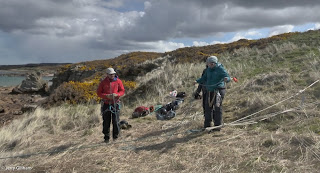Just
36 hours after landing back at Brize Norton Jess and I boarded the sleeper
train up to Inverness, ready to start work for the RSPB. That hectic weekend
took in a day of first aid revision and a nice day on the Aberdeenshire coast expanding
our rope work skills as well as all the contract signing and paperwork. This was all as part of our new jobs as research
assistants for the Seabird Tracking And Research (STAR) project. This is
the final year of work that has been ongoing for a few summers now, formerly
known as Future of Atlantic Marine Environment (FAME), that a number of my
friends and colleagues have participated in.
 |
| While not indulging in any climbing or abseiling, we will be working on the edges of some cliffs and steep slopes. Places where you'd much rather be properly roped up. |
STAR
The aim of STAR, if the title didn’t make clear, is researching seabird behavior - specifically through tracking individuals during the breeding season. The study
focuses on five main species (fulmar, guillemot, kittiwake, razorbill and shag) at a large number of sites around the UK and Ireland. A range of lightweight
devices that can record a birds global position, dive depth and movement have
been deployed and a huge amount of data recovered.
The
first view of this data shows where the birds are spending the majority of
their time away from the nest during egg incubation and chick rearing. We can see key feeding
areas at different times of year, stages of development and between years.
Already this has shown how some birds travel much further than was previously
thought common or even possible. Further analysis can link this to weather and
marine conditions and how these link to poor or successful breeding seasons. Perhaps
the most important reason for identifying the key feeding areas is for
conservation and protection. Marine Protected Areas (MPAs) are a big
issue at the moment and this data will hopefully mean they can be sited in the
best places. Similarly offshore windfarms have a large potential for supplying
clean, green energy, but they can cause problems for wildlife if built in the
wrong location.
In the office
Most of my time down here was spent getting to grips with the
new Mataki tags. Unlike those that have been used previously, the key
advantage of these cutting-edge new tags is that the gps data they collect is
downloaded remotely to a base station, rather than having to recapture the bird
to collect the device back. This means significantly less disturbance to the
individual and the colony. Depending on how often you want to record gps points
the batteries can last from two days to a week, while a combination of
immersion in the sea and picking at it by the bird means tag will fall off in
10 days or so.
As
with any new technology this required a fair amount of testing; learning how
the programming works, checking battery life and downloading range. The best
way to do this is to set the tags up and attach them to the back of your
rucksack when cycling to and from home each day.
 |
| Cambridgeshire: flat. You don't need a bike with a large number of gears. |
After
my time on Bird Island, getting used to spending every day in an office was a
strange adjustment. Although I often had office work there I would generally do
it first thing in the morning or late afternoon, saving the best part of the
day to head out and do my monitoring work. At The Lodge I usually broke up the
day by heading out into the reserve over lunchtime. Being among woodland made a
nice change as I reacquainted myself with species I’d not seen in years
(butterflies, tits and finches) and a few new ones (hobby).
 |
| Peacock butterfly. |
 |
| Distant hobby. |
Flamborough Head
At
the end of May we got our first real taste of field work, heading up to the
reserves at Bempton and Flamborough on the Yorkshire coast. The huge,
seabird-covered cliffs are spectacular. Seeing gannets at such close range was
fantastic, though it wasn’t them we were there for.
 |
| Cliffs packed with auks and kittiwakes. Bempton and Flamborough looking busy. |
Early
in the morning (extremely early in the morning, like 3am early) we awoke and
headed to the cliffs. To reduce disturbance we wanted to complete our work
before the coast path got busy. When handling the birds we try and stay as
quiet as possible and aim to release them in within 6 minutes, studies have
shown when these conditions are met the impact on the birds are minimal.
 |
| Sunrise on the white cliffs at Flamborough. |
Roped
up and sat on the edge of the cliffs at that time in the morning was great. I
saw a barn owl casually hunting back and forth along the edge, at one point
swooping past me with an unfortunate rodent in its beak. With the full moon
dropping over the horizon to my right as a deep orange sun rose on my left I
felt like was in the perfect location for something dramatic to happen. You
know when you look up at a star-filled sky sometimes you feel a small and
insignificant part of the universe? Well at that time and place I felt the
opposite. Like Zaphod beating the total perspective vortex.
Jerry


Thanks Jerry, been wondering what you've been up to, busy!
ReplyDeleteThanks Jerry, been wondering what you've been up to, busy!
ReplyDelete